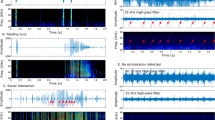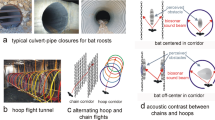Summary
-
1.
Two colonies of little brown bats,Myotis lucifugus (Vespertilionidae), were studied for two summers. The young could not perform practice flights within the buildings where they roosted. Young of estimated relative ages and adults were light-tagged, released, and tracked to determine the development of flying skills and foraging behavior. Orientation sounds were observed and tape-recorded.
-
2.
The earliest flights at ca. 19–20 days of age were usually relatively brief (a few tens of seconds or less) but still remarkable considering the absence of practice. The young at first emerged after adults had left to forage, avoided entering acoustically complex habitats, flew slowly within about 50 m of the roost, and made frequent, awkward landings. They avoided other flying bats and did not pursue insects. More time was spent in rest than flight.
-
3.
Slightly older young, beginning at ca. 22–23 days, gradually increased their flight distance and duration (Table 1) and began to hunt insects in clearings or at the forest edge. Some adopted a ‘flycatcher’ hunting style at this time. They still avoided flying conspecifics.
-
4.
The final phase of development began at about days 24–27 and may last 2 weeks or more. It involved virtually continual flight, insect pursuits, and maneuvers that became indistinguishable from those of adults, and also gradual integration with the adults during emergence, flight along traditional routes, and foraging.
-
5.
The echolocation sounds of young of known and estimated relative ages were recorded in the field, a flight cage, or large room. Again, development was rapid. Landing buzzes always occurred, even in the first flight, although the progressive changes in frequency were sometimes not as uniform as in adults.
-
6.
The pulses during all phases of early flight were of lower frequency than in adults. Those emitted during cruise and approach phases were frequently paired. There is possible ontogenetic and phylogenetic significance to this pairing. Within a few days, the pairing disappeared and within ca. 1 week all echolocation parameters became similar to those of adults (Fig. 1; Table 2).
Similar content being viewed by others
References
Anthony, E.L.P., Kunz, T.H.: Feeding strategies of the little brown bat,Myotis lucifugus, in southern New Hampshire. Ecology58, 775–786 (1977)
Belwood, J.J., Fenton, M.B.: Variation in the diet ofMyotis lucifugus (Chiroptera: Vespertilionidae). Can. J. Zool.54, 1674–1678 (1976)
Black, H.L.: Differential exploitation of moths by the batsEptesicus fuscus andLasiurus cinereus. J. Mammal.53, 598–601 (1972)
Brown, P.E.: Vocal communication in the pallid bat,Antrozous pallidus. Z. Tierpsychol.41, 34–54 (1976)
Brown, P.E., Grinnell, A.D., Harrison, J.B.: The development of hearing in the pallid bat,Antrozous pallidus. J. Comp. Physiol.126, 169–182 (1978)
Buchler, E.R.: A chemiluminescent tag for tracking bats and other small nocturnal animals. J. Mammal.57, 173–176 (1976a)
Buchler, E.R.: The use of echolocation by the wandering shrew,Sorex vagrans. Anim. Behav.24, 858–873 (1976b)
Buchler, E.R.: Prey selection inMyotis lucifugus (Chiroptera: Vespertilionidae). Am. Nat.110, 619–628 (1976c)
Buchler, E.R.: Similarities in design features of orientation sounds used by simpler nonaquatic echolocators. In: Proc. II animal sonar systems symposium. Busnel, R.G. (ed.). New York: Plenum (in press) 1979
Fenton, M.B., Morris, G.K.: Opportunistic feeding by desert bats (Myotis spp.). Can. J. Zool.54, 526–530 (1976)
Gould, E.: Evidence for echolocation in the Tenrecidae of Madagascar. Proc. Am. Philos. Soc.109, 352–360 (1965)
Gould, E.: Studies of maternal-infant communication and development of vocalizations in the batsMyotis andEptesicus. Commun. Behav. Biol.5, 263–313 (1971)
Gould, E.: Neonatal vocalizations in bats of eight genera. J. Mammal.56, 15–29 (1975)
Gould, E., Woolf, N.K., Turner, D.C.: Double-note communication calls in bats: Occurrence in three families. J. Mammal.54, 998–1001 (1973)
Griffin, D.R.: Migrations of New England bats. Bull. Mus. Comp. Zool. Harv. Univ.86, 217–246 (1940)
Griffin, D.R.: Audible and ultrasonic sounds of bats. Experientia7, 448–453 (1951)
Hopkins, C.D., Rossetto, M., Lutjen, A.: A continuous sound spectrum analyser for animal sounds. Z. Tierpsychol.34, 313–320 (1974)
Jones, C.: Growth, development and wing loading in the evening bat,Nycticeius humeralis (Rafinesque). J. Mammal.48, 1–19 (1967)
Kleiman, D.G.: Maternal care, growth rate and development in the noctule (Nyctalus noctula), pipistrelle (Pipistrellus pipistrellus) and serotine (Eptesicus serotinus). J. Zool.157, 187–211 (1969)
Konstantinov, A.I.: Development of echolocation in bats in postnatal ontogenesis. Period. Biol.75, 13–19 (1973)
Kunz, T.H.: Population studies of the cave bat (Myotis velifer): Reproduction, growth and development. Occas. Pap. Mus. Nat. Hist. Univ. Kans.15, 1–43 (1973)
Kunz, T.H.: Reproduction, growth and mortality of the vespertilionid bat,Eptesicus fuscus, in Kansas. Ecology55, 1–113 (1974a)
Kunz, T.H.: Feeding ecology of a temperate insectivorous bat (Myotis velifer). Ecology55, 693–711 (1974b)
Kunz, T.H., Anthony, E.L.P., Rumage, W.T., III: Mortality ofLasiurus borealis borealis following multiple pesticide applications. J. Wildl. Manag.41, 476–483 (1977)
McCue, J.J.G., Bertolini, A.: A portable receiver for ultrasonic waves in the air. IEEE Trans. Sonics Ultrason. GroupSU-11 41–49 (1964)
Medway, L., Pye, J.D.: Echolocation and the systematics of swiftlets. In: Evolutionary ecology. Stonehouse, B., Perrins, C. (eds.), pp. 225–238. Baltimore: University Park 1977
O'Farrell, M.J., Studier, E.H.: Reproduction, growth and development inMyotis thysanodes andM. lucifugus (Chiroptera: Vespertilionidae). Ecology54, 18–30 (1973)
Orr, R.: Natural history of the pallid bat,Antrozous pallidus (Le Conte). Proc. Calif. Acad. Sci.28, 165–246 (1954)
O'Shea, T.J., Vaughan, T.A.: Nocturnal and seasonal activities of the pallid bat,Antrozous pallidus. J. Mammal.58, 269–284 (1977)
Pearson, O.M., Koford, M., Pearson, A.: Reproduction of the lump-nosed bat (Corynorhinus rafinesquei) in California. J. Mammal.33, 273–320 (1952)
Ross, A.: Ecological aspects of the food habits of insectivorous bats. Proc. West. Found. Vertebr. Zool.1, 205–263 (1967)
Sales, G., Pye, J.D.: Ultrasonic communication by animals. New York: Halstead 1974
Sazima, I.: Vertebrates as food items of the woolly false vampire,Chrotopterus auritus. J. Mammal.59, 617–618 (1978)
Thomas, S.P., Suthers, R.A.: The physiology and energetics of bat flight. J. Exp. Biol.57, 317–335 (1972)
Vaughan, T.A.: Nocturnal behavior of the African false vampire bat (Cardioderma cor). J. Mammal.57, 227–248 (1976)
Vaughan, T.A.: Foraging behavior of the giant leaf-nosed bat (Hipposideros commersoni). E. Afr. Wild. J.15, 237–249 (1977)
Whitaker, J.O., Jr.: Food habits of bats from Indiana. Can. J. Zool.50, 877–883 (1972)
Woolf, N.K.: The ontogeny of bat sonar sounds: With special emphasis on sensory deprivation. Unpublished Sc. D. thesis, Johns Hopkins University, Baltimore (1974)
Author information
Authors and Affiliations
Rights and permissions
About this article
Cite this article
Buchler, E.R. The development of flight, foraging, and echolocation in the little brown bat (Myotis lucifugus). Behav Ecol Sociobiol 6, 211–218 (1980). https://doi.org/10.1007/BF00569202
Received:
Accepted:
Issue Date:
DOI: https://doi.org/10.1007/BF00569202




